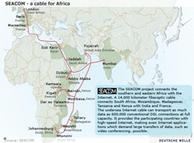In the last two years, there has been a lot of talk about the SEACOM project, which links the coasts of East and South Africa. The project involved the immersion of undersea fibre optic cables that increase speeds and decrease costs for Internet Service Providers and users. We have discussed the SEACOM project on two occasions; when we mentioned the Nation Media Group’s golden jubilee, and when we asked Mbwana Alliy five questions.
There has therefore been a lot of excitement about the prospect of starting new goods and services based on the Internet that are especially for certain markets in Africa. Due the growth in the use of mobile phones, this excitement is further channeled into how mobile applications can be built, used, and developed over the Internet.

If you are getting ideas about how to run a product or service on the Internet in Africa, it is probably wise to check out Internet World Stats (IWS).
The IWS website provides comprehensive and up-to-date information about the penetration and use of the Internet across the African continent. It also provides country-specific data on the growth of Internet use relative to population growth.
For example, did you know that Tanzania has 520,000 Internet users as of June, 2009 (1.3% of the population), whereas her neighbor Kenya has 3,359,600 Internet users as of June/2009 (8.6% of the population)?
With a resource like this, your due diligence is made easy. That is, you don’t have to spend so much time contacting so and so bureau for information before you start an Internet-based project. IWS can be used as a quick reference to make find markets, make projections, and assess progress relative to a given country or Africa’s internet penetration and growth.
With increasing numbers of Internet Service Providers and bandwidth, the focus seems to be shifting not on access, but on how those who currently have access can innovate for their population.
Related Links:


As noted, focus is shifting from access to what is actually done with that access.Having access to the internet is akin to having a fast car, unless you know how to drive, it can be of little use. But then again one may argue, without having a car you don’t even have a point to learn how to drive.
Some sparks are called for, if only to ignite a larger fire. The Yellow Masai venture ( a clever mix of Yero as in the Masai word and Yellow as in the Yellow pages) is a challenge to all IT enterpreneurs and professionals.
I find the Internet World Stats (IWS) statistics a bit confusing. They say in 2000, Tanzania had 50,000 internet users. In 2002, it went up to 500,000. It also went up to 820,000 in 2005 before dropping to 520,000 in 2009.
They also says that in 2000, Tanzania population was 14,712,000, then it went down to 13,874,610 in 2002, then down gain to 12,247,589 in 2005, before jumping dramatically to 41,048,532 in 2009. Is this corrent?
Our Bureau of Statistics says that in 2002, the population was 34,443,603 whilst the Internet World Stats (IWS) says it was 13,874,610. Which one should we trust?
Whether the stats are correct or not, the issue remains, Tanzanians are not using the internet like her neighbours, the cafes are few; most of the time there is no connection or electricity.
Prices for broadband connection and web surfing are ridiculously high, schools, libraries, colleges and universities have not got enough facilities to cater for its students.
Most people are so poor that they cannot afford to buy computers and its accessories.
It’s a bleak situation really.
And CCM will tell us they doing a good job!
Bah..!